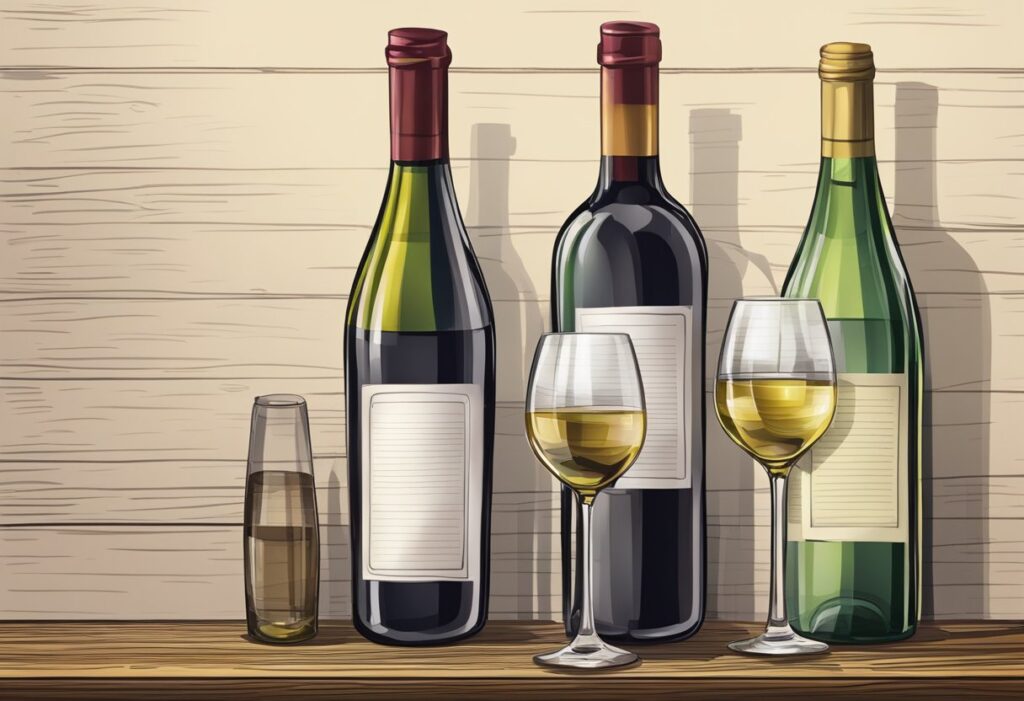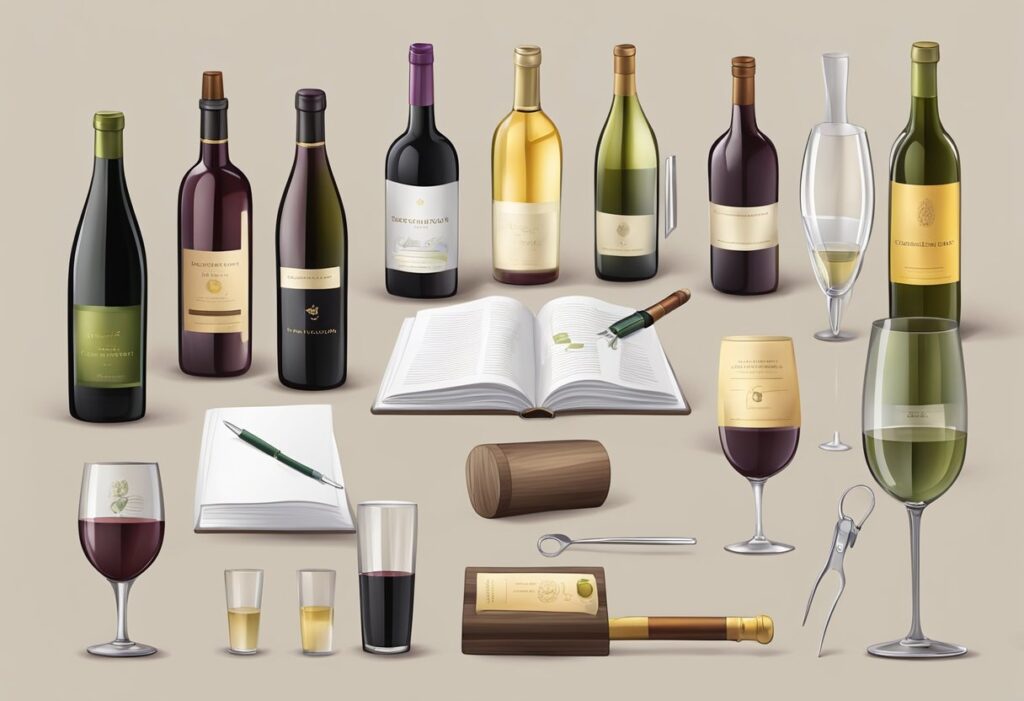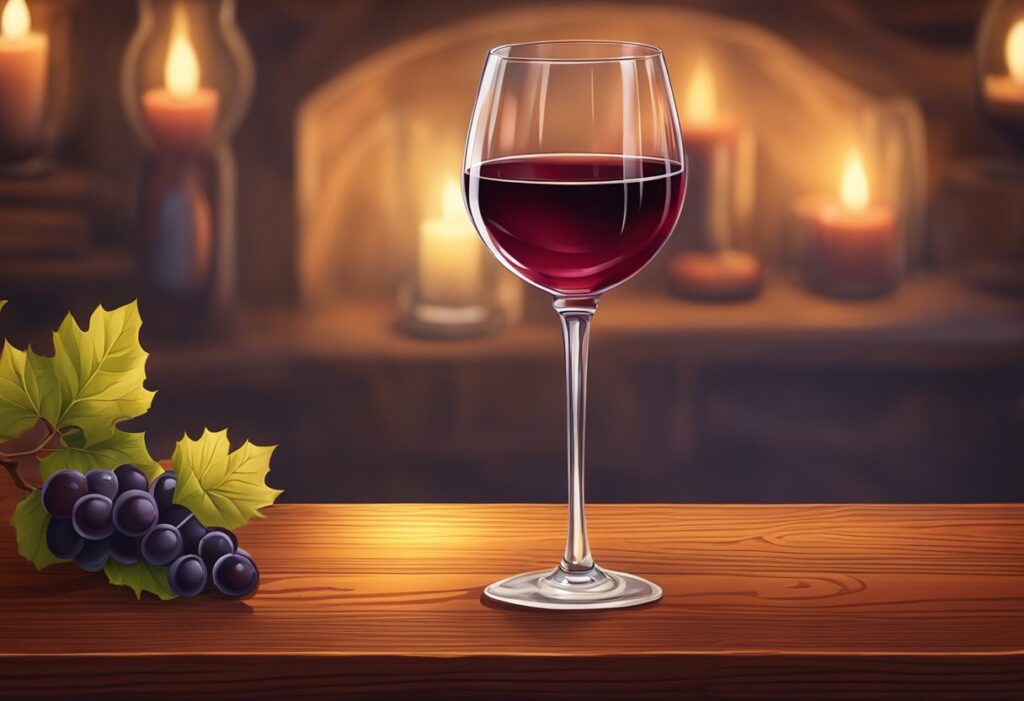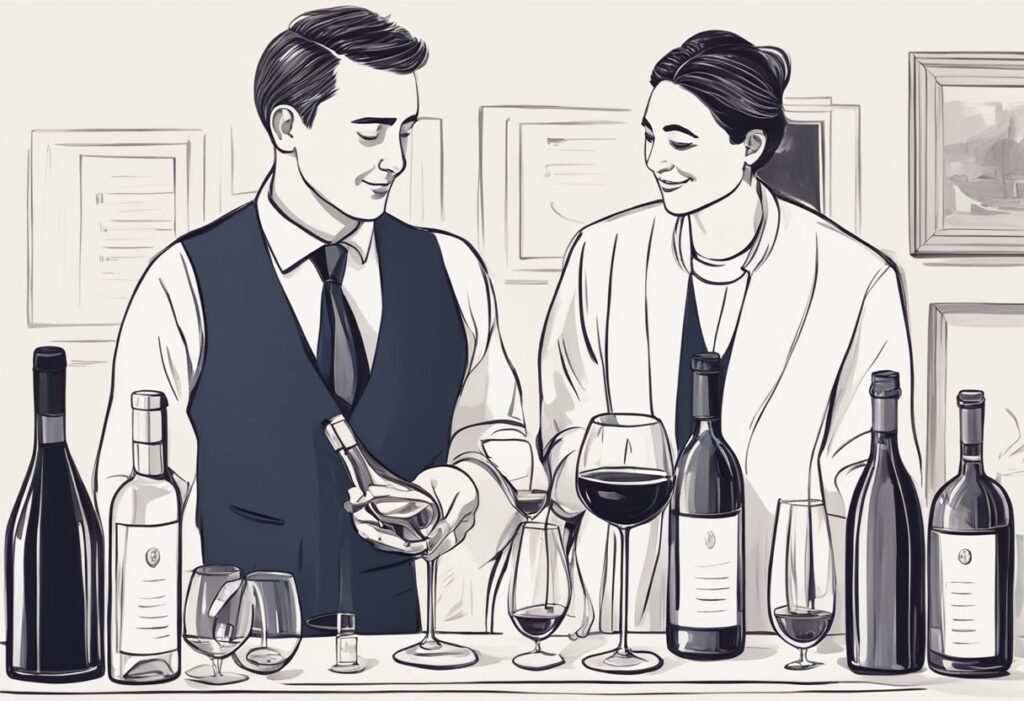If you’re a wine lover, you know that wine tasting is an art form that requires practice and patience. Whether you’re a beginner or an experienced wine connoisseur, understanding the basics of wine tasting is essential for appreciating the nuances of each wine. In this wine tasting guide, we’ll take you through the process of wine tasting, from understanding the types of wine to identifying aromas and flavors, to pairing wine with food.
Understanding the basics of wine tasting can seem daunting, but with a little practice, you’ll be able to identify the characteristics of each wine and appreciate the unique qualities that make each bottle special.
We’ll break down the wine tasting process into easy-to-follow steps, so you can confidently taste and evaluate any wine. From the visual inspection of the wine to the taste structure and flavors, we’ll cover everything you need to know to develop your palate and become a wine tasting expert.
Key Takeaways
- Understanding the different types of wine is essential for wine tasting.
- The wine tasting process involves four steps: look, smell, taste, and assess.
- Pairing wine with food can enhance the flavors of both the wine and the food.
Understanding Wine Tasting
If you’re new to wine tasting, it can be a bit intimidating. However, with a little practice and some tips and techniques, you’ll be able to appreciate and enjoy wine like a pro. In this section, we’ll cover the basics of wine tasting and some techniques to help you get the most out of your wine tasting experience.
The Basics of Wine Tasting
Wine tasting is the process of evaluating and analyzing wine using your senses of sight, smell, and taste. The goal is to identify the wine’s characteristics, including its flavor, aroma, body, acidity, tannins, and finish.
To get started with wine tasting, you’ll need to follow a few basic steps:
- Look at the wine – examine the color and clarity of the wine in the glass.
- Smell the wine – take a deep sniff of the wine to identify its aroma.
- Taste the wine – take a sip of the wine and let it linger in your mouth to identify its flavor and texture.
- Evaluate the finish – notice the aftertaste and how long it lasts.
Wine Tasting Techniques
There are a variety of techniques that wine tasters use to get the most out of their wine tasting experience. Here are a few to get you started:
- Use a clean glass – make sure your glass is clean and free of any residue from previous wines.
- Swirl the wine – gently swirl the wine in your glass to release its aroma and flavor.
- Take notes – keep track of your observations and impressions of each wine.
- Spit or dump – if you’re tasting multiple wines, you may want to spit or dump the wine to avoid getting too intoxicated.
- Compare and contrast – taste multiple wines side-by-side to compare and contrast their characteristics.
With these tips and techniques, you’ll be well on your way to becoming a wine tasting pro. Remember to practice and have fun with it!
Types of Wine
When it comes to wine, there are three main categories: red, white, and sparkling. Each type of wine has its own unique characteristics and flavor profile. In this section, we’ll take a closer look at each of these wine types and some of the varietals that fall under them.
Red Wines
Red wines are made from dark-colored grapes and are typically heavier and more full-bodied than white wines. Some popular red wine varietals include:
- Cabernet Sauvignon: This is a full-bodied wine with bold flavors of blackcurrant, blackberry, and cedar. It pairs well with red meat and hearty dishes.
- Syrah: Syrah is a bold wine with flavors of blackberry, plum, and spice. It pairs well with grilled meats and spicy dishes.
- Malbec: Malbec is a medium to full-bodied wine with flavors of blackberry, plum, and chocolate. It pairs well with grilled meats and strong cheeses.
- Grenache: Grenache is a medium-bodied wine with flavors of red fruit, spice, and earthy notes. It pairs well with roasted meats and vegetables.
White Wines

White wines are made from green or yellow grapes and are typically lighter and more refreshing than red wines. Some popular white wine varietals include:
- Chardonnay: Chardonnay is a full-bodied wine with flavors of green apple, vanilla, and oak. It pairs well with seafood and creamy dishes.
- Pinot Noir: Pinot Noir is a light to medium-bodied wine with flavors of red fruit, spice, and earthy notes. It pairs well with poultry and light pasta dishes.
- Sauvignon Blanc: Sauvignon Blanc is a light-bodied wine with flavors of citrus, green apple, and grass. It pairs well with seafood and light salads.
- Riesling: Riesling is a sweet wine with flavors of peach, apricot, and honey. It pairs well with spicy dishes and desserts.
Sparkling Wines
Sparkling wines are carbonated wines that can be either white or red. They are typically served chilled and are a popular choice for celebrations. Some popular sparkling wine varietals include:
- Champagne: Champagne is a sparkling wine that is made in the Champagne region of France. It is typically made from Chardonnay, Pinot Noir, and Pinot Meunier grapes.
- Prosecco: Prosecco is a sparkling wine that is made in Italy. It is typically made from the Glera grape and has flavors of green apple and citrus.
- Cava: Cava is a sparkling wine that is made in Spain. It is typically made from the Macabeo, Xarello, and Parellada grapes and has flavors of citrus and almond.
Now that you have a better understanding of the different types of wine, you can start exploring different varietals and finding the ones that you enjoy the most. Remember to try different wines with different foods to find the perfect pairing. Cheers!
The Tasting Process
Wine tasting can be an enjoyable and rewarding experience, but it can also be intimidating if you don’t know what to expect. Fortunately, the process is straightforward and easy to follow. By using your senses, you can learn to identify the different characteristics of wine and appreciate its unique qualities.
Look
The first step in the wine tasting process is to observe the wine’s appearance. Hold the glass up to the light and take note of its color and clarity. The color can give you an indication of the wine’s age, grape variety, and winemaking techniques. For example, red wines tend to become lighter in color as they age, while white wines can become darker.
Swirl
The next step is to swirl the wine in your glass. This helps to release its aromas and flavors. Hold the stem of the glass and gently swirl the wine in a circular motion. This action is known as “swirling” or “swishing.” Be careful not to spill the wine!
Smell
After swirling the wine, bring the glass to your nose and take a deep sniff. This step is crucial because the aroma of the wine can give you valuable information about its quality and characteristics. Try to identify the different scents that you detect, such as fruit, flowers, spices, or oak. This process is known as “smelling.”
Taste
Now it’s time to taste the wine. Take a small sip and let it sit on your tongue for a few seconds. Pay attention to the wine’s sweetness, acidity, tannins, and overall flavor. Swirl the wine in your mouth to fully experience its taste. This step is known as “tasting.”
Finish
The final step is to evaluate the wine’s finish. This refers to the aftertaste that lingers in your mouth after you swallow or spit out the wine. A good wine will have a long and pleasant finish, while a poor wine may have a bitter or sour aftertaste. This step is important because it can give you an indication of the wine’s overall quality.
By following these steps, you can learn to appreciate the nuances of wine and develop your palate. Remember to take your time and enjoy the process. Cheers!
Wine Aromas and Flavors
When it comes to wine tasting, one of the most important aspects is identifying the different aromas and flavors in the wine. This can be a challenging task, but with practice and knowledge, you can become a pro at it.
Fruit Flavors
One of the most common flavors found in wine is fruit flavors. Depending on the type of wine, you may taste flavors like citrus, berry, pear, or tropical fruits. These fruit flavors are often the primary flavors that you will taste when you take a sip of wine.
Secondary Aromas
In addition to fruit flavors, you may also notice secondary aromas in the wine. These aromas can come from the winemaking process and the type of oak that was used to age the wine. For example, you may taste flavors like vanilla, butter, or cream in a wine that has been aged in oak barrels.
Tertiary Aromas
Finally, there are tertiary aromas, which are the aromas that develop as the wine ages. These aromas can include floral notes, as well as more complex flavors like tart, sweet, bitter, or sour.
To identify the different aromas and flavors in wine, it’s important to use all of your senses. Take a look at the color of the wine, smell the wine, and then take a sip. As you taste the wine, pay attention to the different flavors that you are experiencing.
Understanding Wine Characteristics
When it comes to wine tasting, understanding the characteristics of wine is crucial. The color, body, acidity, tannins, and sweetness of wine can all affect how it tastes and smells. In this section, we’ll take a closer look at each of these characteristics.
Color
The color of wine can give you clues about its age, flavor, and body. Red wines can range from dark and opaque to light and translucent. Common red wine colors include purple, ruby, and garnet. White wines can range from clear to pale gold. Some white wines may even have a brownish hue. When you’re tasting wine, take a close look at its color to get a sense of what you can expect from its taste.
Body
The body of wine refers to how heavy or light it feels in your mouth. A wine with a light body will feel thin and watery, while a full-bodied wine will feel heavier and more substantial. The body of wine is affected by factors such as alcohol content, tannins, and residual sugar. When you’re tasting wine, pay attention to its body to get a sense of how it will feel in your mouth.
Acidity
Acidity is an important characteristic of wine that can affect its taste and longevity. Wines with high acidity will taste tart and crisp, while wines with low acidity will taste softer and rounder. Acidity can also help preserve wine and prevent it from spoiling. When you’re tasting wine, pay attention to how acidic it tastes to get a sense of its overall flavor profile.
Tannins
Tannins are compounds found in the skins, stems, and seeds of grapes that give wine its astringency and bitterness. Tannins can also help preserve wine and give it structure. Wines with high tannins will feel more drying and puckering in your mouth, while wines with low tannins will feel smoother and more supple. When you’re tasting wine, pay attention to its tannin level to get a sense of how it will feel in your mouth.
Sweetness
Sweetness is a key characteristic of wine that can affect its taste and food pairing. Wines with high sugar content will taste sweet, while wines with low sugar content will taste dry. Sweetness can also affect the alcohol content of wine, as sugar is converted to alcohol during the fermentation process. When you’re tasting wine, pay attention to its sweetness level to get a sense of how it will pair with different types of food.
Wine Quality Indicators

When tasting wine, there are several indicators that can help you determine its quality. Some of the most important factors to consider are the vintage, terroir, and producer.
Vintage
The vintage refers to the year that the grapes were harvested. In general, wines from better vintages are of higher quality. This is because the weather conditions during the growing season can have a significant impact on the flavor and aroma of the grapes. For example, a hot and dry growing season can result in grapes with more concentrated flavors and aromas, while a cool and wet growing season can result in grapes with more subtle and delicate flavors.
Terroir
The terroir refers to the environmental factors that influence the grapes, such as the soil, climate, and topography of the vineyard. Wines from different terroirs can have very different flavors and aromas, even if they are made from the same grape variety. For example, a wine from a vineyard with rocky soil and a cool climate might have a more mineral and earthy flavor, while a wine from a vineyard with sandy soil and a warm climate might have a more fruity and floral flavor.
Producer
The producer of the wine can also have a significant impact on its quality. A skilled and experienced winemaker can use their knowledge and expertise to create a wine that is well-balanced and complex. On the other hand, a less experienced winemaker might produce a wine that is unbalanced or lacks depth.
When evaluating the quality of a wine, it is important to consider all of these factors. By paying attention to the vintage, terroir, and producer, you can gain a better understanding of the flavor and aroma of the wine, and make a more informed decision about whether or not it is worth purchasing.
Wine Tasting Tools

To fully appreciate the flavors and aromas of wine, you need the right tools. Here are the essential tools you’ll need to conduct a proper wine tasting:
Wine Glass
The wine glass is one of the most important tools for wine tasting. A good wine glass should have a large bowl that allows you to swirl the wine and release its aromas. The shape of the glass also affects how the wine hits your tongue, which can impact your perception of the wine’s flavor. Look for glasses that are made of thin glassware, as this allows you to taste the wine without any interference from the glass itself.
Cork
The cork is an important part of the wine bottle, as it helps to seal the wine and protect it from oxidation. When tasting wine, it’s important to examine the cork to make sure it’s in good condition. A dry or cracked cork can indicate that the wine has been exposed to air, which can affect its flavor.
Stem
The stem of the wine glass is an important feature that is often overlooked. Holding the glass by the stem prevents your hand from warming up the wine, which can affect its temperature and flavor. It also prevents fingerprints on the bowl, which can detract from the wine’s appearance.
When it comes to wine glasses, there are many different types to choose from. Some glasses are designed for specific types of wine, while others are more versatile. Ultimately, the most important thing is to choose a glass that feels comfortable in your hand and allows you to fully experience the wine’s aromas and flavors.
Pairing Wine and Food

Pairing wine with food is an art that can enhance the flavors of both the wine and the food. Here are some tips to help you make the perfect pairing:
Consider the Intensity of the Wine and Food
The intensity of the wine and food should complement each other. A bold red wine like Cabernet Sauvignon pairs well with red meat, while a light white wine like Pinot Grigio pairs well with seafood and chicken. The intensity of the food should not overpower the wine, and vice versa.
Look at the Flavors
The flavors in the wine and food should also complement each other. For example, a Sauvignon Blanc with its citrus flavors pairs well with a salad with a citrus vinaigrette. A Chardonnay with its buttery flavors pairs well with dishes that have a creamy sauce.
Consider the Acidity
The acidity of the wine should be higher than the acidity of the food. This is because the acidity in the wine can cut through the richness of the food. For example, a high-acidic wine like a Riesling pairs well with spicy food because it can balance out the heat.
Pairing with Cheese
Cheese is a common pairing with wine. The general rule of thumb is to pair white wine with soft cheese and red wine with hard cheese. However, this is not a hard and fast rule. Experiment with different pairings to find what works best for you.
Don’t Be Afraid to Experiment
Pairing wine with food is not an exact science. Don’t be afraid to experiment and try different pairings to find what works best for you. Remember, the most important thing is to enjoy the wine and food together.
Additional Wine Tasting Tips

Now that you know the basics of wine tasting, it’s time to dive deeper and explore some additional tips that will help you become a true wine connoisseur.
Water is Your Friend
When tasting wine, it’s important to have a glass of water nearby. This will help you cleanse your palate between tastings, so you can fully appreciate the unique flavors of each wine. Take a sip of water, swish it around in your mouth, and then spit it out before moving on to the next wine.
Pay Attention to the Legs
When you swirl your wine in the glass, you’ll notice that it leaves behind “legs” or “tears” on the sides of the glass. These are caused by the alcohol content and can give you an idea of the wine’s body and alcohol level. Thicker legs indicate a higher alcohol content and a fuller body.
Clarity and Opacity
The clarity and opacity of a wine can also give you clues about its quality. A clear wine is generally considered to be of higher quality than a cloudy wine. However, some wines, such as unfiltered or natural wines, may be intentionally cloudy. In terms of opacity, a lighter wine will be more translucent, while a full-bodied wine will be more opaque.
Viscosity
Viscosity refers to the thickness or “mouthfeel” of a wine. A wine with high viscosity will feel heavier and more substantial in your mouth. This can be an indication of a full-bodied wine with a high alcohol content.
Tasting Notes
When tasting wine, it’s important to take notes on what you smell and taste. This will help you remember the characteristics of each wine and compare them to others you’ve tasted. Use descriptive words like fruity, floral, spicy, or oaky to describe the wine’s aroma and flavor.
Trust Your Own Taste
While sommeliers and wine guides can be helpful, ultimately, your own taste is the most important factor when it comes to wine. Don’t be afraid to trust your own palate and try new things. Experiment with different varietals, regions, and styles to discover what you like best.

